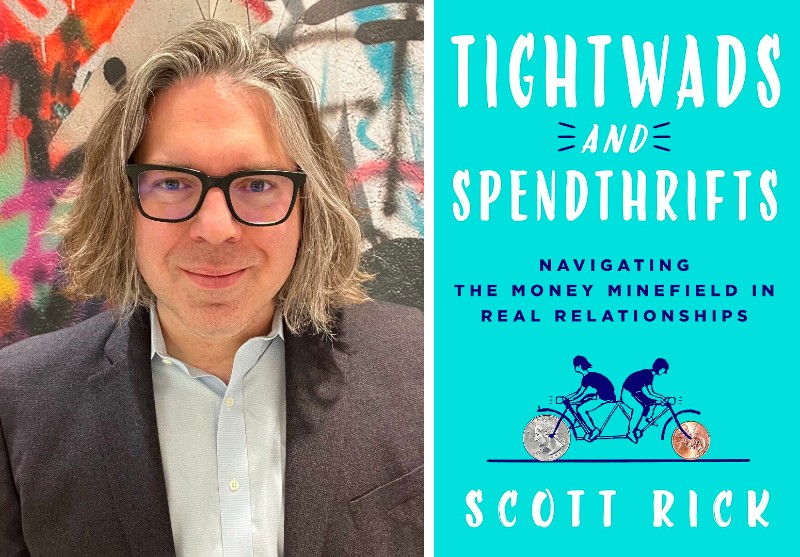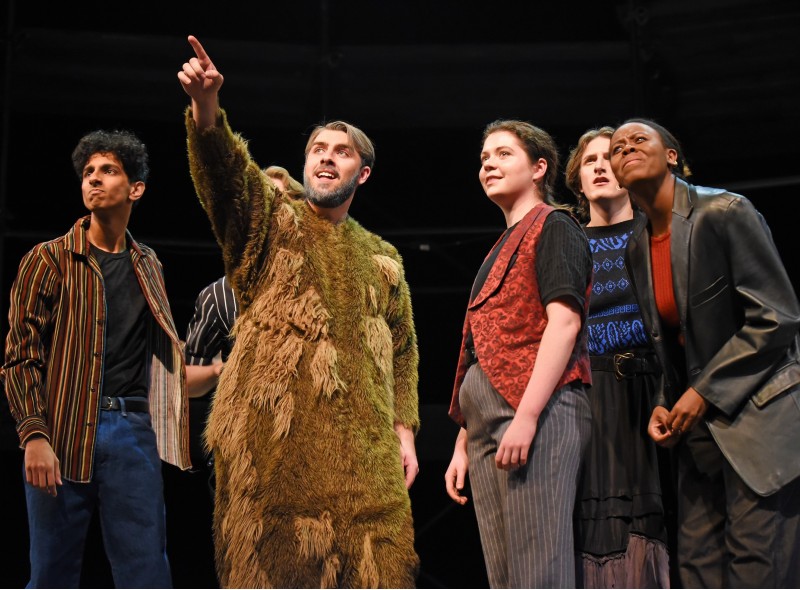Susan Goethel Campbell’s “Garden Repairs” traverses the intersection of natural and man-made worlds

Not long before visiting Ferndale-based artist Susan Goethel Campbell’s Garden Repairs installation at the U-M’s Institute of the Humanities, I’d shared a photograph on social media of a cluster of snow-dusted daffodils in my backyard, shriveled and hunched over. I’d been struck by how often nature mirrors human gesture; how these flowers visibly conveyed what many of us were feeling that morning, as we pulled winter coats and gloves back out of our closets, just days after walking around in shorts. I’d wondered if the natural world shaped the way our physical bodies communicate emotion, or if this is all, in fact, subtle, visible evidence of our inter-relationship with each other.
As it happens, this train of thought was a perfect foundation for experiencing Campbell’s work, which marries the natural and man-made worlds in surprising ways.
Theatre Nova's "the ripple, the wave that carried me home" explores how a family deals with a long fight for social justice

A social change agent who’s also a parent lives inside a paradox: Though they’re often driven by hopes of making the world a better place for their child, they must necessarily invest a vast amount of time and passion (that might otherwise be spent on the child) into their cause to even have a chance at moving the needle—and that child’s resentment can all-too-easily take root and grow.
This is one of the primary conflicts at the heart of Christina Anderson’s play the ripple, the wave that carried me home, now on stage at Theatre Nova. The 90-minute drama focuses on Janice (Bryana Hall), a woman living with her husband and sons in Ohio in 1992 as the L.A. riots—sparked by acquittals for the police officers who brutally beat Rodney King—unfold on television.
The Acting Office: Andrew Otchere turned his University of Michigan studies into the comedy "Becoming BFA: The Showcase Showdown"

Sometimes the most challenging part of a creative project is figuring out the best means of communicating a story to an audience.
In the case of Becoming BFA: The Showcase Showdown, creator Andrew Otchere—who graduated from the University of Michigan last spring with a degree in acting—initially thought he and a handful of student collaborators would be writing a television pilot when they gathered during their junior year.
“Then, as we talked about the concept, one aspect that became most important to me was that I really wanted to create something that would build a stronger community within my class of actors,” said Otchere, who just recently moved to Los Angeles (where he’s auditioning and writing). “I wanted to make sure that everybody was included. … By our senior year, there were about 18 of us … so it became a little too much to just be a pilot episode. There would be too many characters.”
So this would-be pilot episode became a short film that ran nearly 40 minutes.
But that wasn’t the final word on the project’s format, either. As Otchere submitted BFA to film festivals—it landed a screening at the Laughs After Dark Comedy Festival in Las Vegas—he started getting feedback that pointed him in a different direction entirely.
“One of the best pieces of advice I got was about how we are currently in the height of the digital age, where TikTok and short-form video has taken control,” Otchere said. “And being a story that focuses on the Gen Z perspective, which the target audience is also in … it only made sense to make episodes that are shorter, so we could put it out on TikTok, or create a mini web series of it. So that inspired me to cut [the film] up into nine five-minute episodes. And since it took form as a web series, it just felt like it was received so much better. People were excited for new episodes and gave a lot of feedback.”
The seed for making Becoming BFA—which focuses on students preparing for their Senior Showcase, when they get to perform in front of entertainment industry professionals—took root in Otchere’s freshman year (2019-20), when he and his fellow student actors joked about feeling like they were living in a reality show.
Encore Theatre's take on Stephen Sondheim’s fairy-tale mashup "Into the Woods" is filled with powerhouse vocals

It’s fitting that I watched Encore Musical Theatre Company’s new production of Into the Woods with my 12-year-old daughter.
Not just because the girl can sing every word of the show’s patter song (“Your Fault”)—she used to fall asleep listening to the show’s cast recording each night—but also because she now lives in that interstitial, fog-laden forest known as middle school, where preteens blindly fumble their way out of childhood.
And frankly, if I had to name one show that’s about the terrifyingly fraught and difficult process of growing up, it would be Stephen Sondheim’s Into the Woods.
A fairy-tale mashup that premiered on Broadway in 1987—long before the word “mashup” became such a regular part of our lexicon—Woods interweaves the stories of Cinderella (Ash Moran), Rapunzel (Lucia Flowers), Little Red Riding Hood (Sienna Berkseth), and Jack (Tsumari Patterson) and the Beanstalk.
How? By way of a cursed baker (Marcus Jordan) and his wife (Jessica Grové), who can’t have children until they gather the four items requested by the old witch next door (Jennifer Horne). But even when the couple succeeds, and everyone—fairy-tale protagonists included—gets what they want, in its darker second act Woods dares to venture beyond “happily ever after” and ask, “OK, now what?”
For Love and Money: U-M professor Scott Rick explores how couples navigate finances in "Tightwads and Spendthrifts"

In my family, I’m the person who insists on setting apart the cans that can be returned for deposit, while my husband says, “What do you get, three dollars? Not worth it.”
Perhaps not. But different philosophies about money, at the macro and micro level, are all-too-common in marriage. I mean, there’s a reason that finances always make the list of “things couples fight most about,” right?
To address these differences, Scott Rick, a U-M Ross School of Business marketing professor, has a new book called Tightwads and Spendthrifts: Navigating the Money Minefield in Real Relationships. Billed as distinct from conventional self-help or personal finance books, the book instead uses behavioral science as scaffolding for a broader discussion of how spending plays into our sense of personal identity; why we’re sometimes attracted to people who are quite unlike ourselves (in terms of spending); and practical ways to work through money-related conflicts.
Peak of Success: Nick Baumgardner and Mark Snyder Revisit U-M Wolverines’ 1997 National Championship Season in New “Mountaintop” Book

Books about the University of Michigan’s football team could easily fill several shelves, but strangely, one thing that’s been missing is a deep-dive chronicle of the 1997 National Championship season.
Don’t worry, though. Longtime local sports journalists Nick Baumgardner and Mark Snyder just filled that gap by way of a brand new book, Mountaintop: The Inside Story of Michigan’s 1997 National Title Climb.
Yet the arrival of Mountaintop inevitably begs the question: Why did it take so long for a book about that hallowed season to appear in the world?
“A lot of it has to do with Lloyd Carr, who doesn’t like to talk about himself a lot,” said Baumgardner, who now writes about the Detroit Lions for The Athletic. “That’s a big part of it. … The other thing, too, is a lot of these [former players] … they’re protective of it, and they aren’t very trusting about people getting their stories right, so it’s a hard group to crack.”
But crack it he (and Snyder) did, interviewing, over the course of two years, not just every surviving member of the team that they could track down, but also coaches, staffers, and others while doing loads of research, too.
“Mark Snyder came to me; he’d covered Michigan at the Free Press for a long time, and The Oakland Press and The Michigan Daily, and he’d known Lloyd for a long time ... he was certainly closer to him than I was,” Baumgardner said. “Lloyd and a few other people from that era came to Mark with the idea of maybe doing a book, since no one had done one on the ‘97 team.”
Deck Halls the Halls With Boughs of Corn: Encore Theatre's "White Christmas" hits all the right nostalgic spots

As a starting point, let’s just agree: White Christmas is pure, nostalgic corn.
But ever since I was a kid, watching the 1954 Bing Crosby movie with my musical-loving mom, it’s always gotten me right in the feels. The world-wise romantic leads who initially dislike each other? The outwardly gruff but paternal General who’s deeply beloved by his men? The snow that refuses to fall in Vermont until conflicts are resolved, and love and goodness prevail?
Like it’s on the cob, ready to be shucked, people.
But recognizing how a story blatantly pulls on your heartstrings sometimes does little to defuse its impact, which is why I was all too happy to check out the stage musical adaptation of White Christmas at Dexter’s Encore Theatre.
Much Ado: U-M Theatre's "Imogen Says Nothing" bears bizarre and haunting moments

U-M theater professor Malcolm Tulip has long established a reputation for bringing challenging, provocative productions to local stages, going back to his days as a director (and performer) at the sadly defunct Performance Network Theatre.
So it was no surprise to find Tulip at the helm of the U-M theater department’s strange, darkly haunting production of Aditi Brennan Kapil’s Imogen Says Nothing, mounted at the Power Center this past weekend. Inspired by a character, Imogen, who has no lines, but is nonetheless mentioned in the first folio edition of Shakespeare’s Much Ado About Nothing, the play imagines a woman who fights to perform on stage in Shakespeare’s time, when only men played theatrical roles (by law!), and campaigns to appear in the first written version of the play, too.
Plus, there are bears.
Imogen is a former bear (!) who has escaped the bear-baiting arena next to the Globe Theatre, which hearkens back to one of Shakespeare’s most famous stage directions, in The Winter’s Tale: “Exit, pursued by a bear.”
While enmeshed with a troupe of actors, Imogen confronts her former peers, and the line that encapsulates the play, “It is a lonesome thing to be absent,” further expands its meaning.
"Things Hidden Since the Foundation of the World" Explores the Challenges of Information Overload and Ubiquity

When you Google the name of the Javaad Alipoor Company’s theatrical production Things Hidden Since the Foundation of the World, you learn this grandiose mouthful of a title was originally used by French philosopher René Girard for a book he wrote.
To learn a little more, you might read a brief overview of Girard’s mimetic theory, which posits that humans don’t know what to want, so we look to others and imitate their desires.
Wait. You came here for a review of Alipoor’s show of that name presented by UMS this week at the University of Michigan’s Arthur Miller Theatre, right? Sorry!
Yet this classic Digital Age digression demonstrates precisely what’s at the heart of Alipoor’s innovative 90-minute show, which was written with Chris Thorpe. Though we know, and are constantly reminded, that almost any information we could possibly want is now at our internet-addicted fingertips. In response, we go online like a reflex with the idea that “facts” provide us with understanding, or that the two things are somehow synonymous, is a dangerous illusion.
Using the unsolved, brutal 1992 murder of Iranian pop star (and refugee) Fereydoun Farrokhzad—who fled Iran during the Islamic Revolution in 1979—as the show’s base of operations, Alipoor integrates video and an onstage, fictional true crime podcast (as well as some nifty theatrical sleight of hand) to explore the case, and more broadly, the link between contemporary technology and politics.
Kelli O’Hara brings the bright lights of Broadway to the Michigan Theater

Kelli O’Hara is one of those versatile Broadway stars who shines in every show she’s in.
She originated the role of Clara in The Light in the Piazza; played feisty union leader Babe opposite Harry Connick Jr. in The Pajama Game; washed a man right out of her hair as Nellie Forbush in South Pacific; originated the role of Francesca in the stage musical adaptation of The Bridges of Madison County; and charmed her young charges, royalty, and audiences alike in The King and I, for which O’Hara won the 2015 Tony Award for Best Performance by a Leading Actress in a Musical.
All the other O’Hara performances I mentioned earned her Tony nominations, too, plus two more besides: Kiss Me, Kate and Nice Work If You Can Get It. So to call O’Hara one of our era’s greatest leading ladies of the stage isn’t hyperbole; it’s just true.
And although O’Hara’s slated to star in the world premiere Broadway musical adaptation of Days of Wine and Roses, scheduled to start previews January 6, she’s also recently been performing concerts in different parts of the country, and she’s headed to Ann Arbor’s Michigan Theater on Sunday, November 12 at 7 pm.
In advance of the show, the native Oklahoman answered a few questions via email about what inspired the concert tour; her newest upcoming show; and her memories of working alongside Ann Arbor native Ashley Park in The King and I.


































